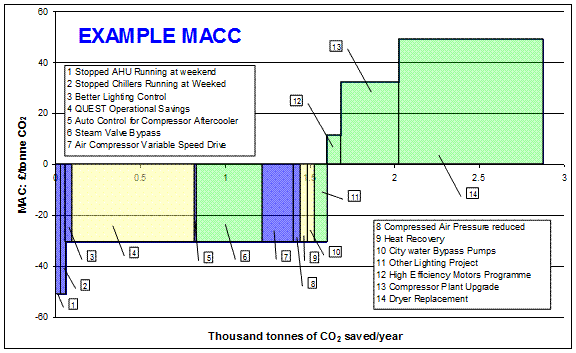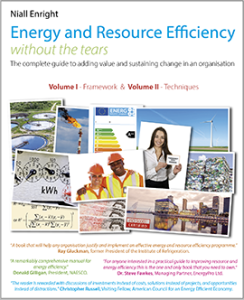But the full cost of these allowances will be recycled to the CRC participants, with a penalty or bonus which depends on their League Table position. In the first year of the CRC, the penalty or bonus is ±10% so, in simplistic terms, the “value at risk”, the difference between being top or bottom of the League Table for our example organisation is ±£8,695, i.e. £17,390 or 1.7% of the cost of energy.
If we examine what happens in future years of the scheme we can see a number of factors increasing this value at risk. First of all the ±10% becomes ±20% in the financial year starting April 2011 and rises each year up to ±50% in FY2015. If nothing else changed that would mean that our organisation would now have a value at risk of £86,952 in 2015 or 8.7% of their energy costs. However this is not the only factor at work because in FY2013 the CO2 allowances will move from having a fixed price of £12/tonne to being auctioned, when it is widely expected that the price will rise, as the government limits the number of allowances available.
Under the EU-Emissions Trading Scheme, the price of CO2 allowances has recently been forecast out to 2013 and 2016 by Point Carbon at €28 and €37 respectively. If we assume that the CRC emissions allowances cost the same (they cannot cost more because of the safety valve mechanism the Government has proposed) then we see the financial impact of the CRC start to rise significantly.
Figure 2: The potential value at risk in the CRC rises rapidly in the early years.
So, taking possible CO2 prices into account, the difference between being top or bottom of the league table in 2014 is could be equivalent to around 20% of the cost of energy, rising to over 30% in 2020. That’s a big increase on the 1.7% mentioned earlier. However, the picture is even more complex and the value at risk certainly higher, as the recycle payments are based not on what an organisation pays into the scheme for allowances but on their proportion of the total emissions in the first year of the CRC.
The effect of this is that early reductions in emissions compared to the Footprint Emissions, can pay handsomely. For every 1% that our organisation decreases their emissions, assuming all other organisations stay the same, they gain approximately 1% more £ in the recycling payment. The converse is also true, for every 1% that t emissions increase; they lose 1% of their recycling payment. This is in addition to the effect of the Bonus or Penalty.
Of course the key to the previous example is the phrase “assuming all other organisations stay the same”. The reality is that all other organisations will be aiming to reduce their emissions too. What is clear is that if our organisation falls behind others in the relative pace of emissions reductions the cost to them could be equivalent to a significant percentage of their current energy bills.
The result is that all participants in the CRC are strongly incentivised in both financial and reputational terms, to put in place a programme of continuous reductions in emissions. Energy efficiency is the main tool to achieve this (the other is self-supply of renewable energy, but this is unlikely to be as financially attractive given that government subsidies cannot be claimed).
The first question that arises is “when should I start”? The answer for most organisations is “as soon as possible”, for two reasons. First, while the financial value at risk from the CRC in year one is low (1.7%), the cost of energy is over 50x higher and reducing cost makes sense at any time. Second, reducing emissions in absolute terms or per unit of activity is a requirement if an organisation is to get the Carbon Trust Standard – which in turn will influence the organisations’ League Table position in the early years of the CRC. There is certainly no justification for holding back from making investments in energy efficiency on the basis that “it is best to have high Footprint Emissions” since the relative value of energy versus CRC recycle payments make energy savings today much more valuable than emissions savings later.
So the next consideration is what the energy efficiency programme should look like if it is to deliver long-term improvements in energy consumption. Given the recent credit crunch, one of the important objectives for many CRC participants will be to deliver efficiency at the lowest possible cost.
The characteristic of no and low cost energy savings is that there are usually a large number of relatively small value projects, many of which are oriented to changing ’people’s behaviour or improving the operation of existing equipment. One way of capturing these opportunities and driving them to implementation is to use an Opportunities Database, typically based on a spreadsheet, not an elaborate IT application.
The Opportunities Database should capture every idea for reducing energy use and then track the idea through various stages: Identified, Feasibility Assessment, Feasible, Funding Requested, Funding approved, and Implemented. This has a number of benefits. Firstly, the scale and value of the opportunities can be fully appreciated. Sometimes small projects put forwards singly can fail to get support because they are not considered material, whereas if there is basket of projects that will deliver a large saving with a very attractive payback this can get greater support. Secondly, if there seems to be a large number of projects “stalled” at a particular point, one can identify and remove these barriers to energy efficiency. Third the database serves as the corporate knowledge-base of what works and what doesn’t and forms the basis for forecasting future energy reductions.
Recognising that the skills required to identify these projects are rather specialised, many organisations will employ external consultants to undertake energy audits and so populate their equivalent of the Opportunities Database. However, it is important that the right consultants are selected. Many equipment manufacturers and engineering firms will go straight to the large plant, the boilers and chillers, and fail to quantify the opportunities around behaviour and low capex investments.
Having created a list of opportunities, one valuable way to present these is in what is called a Marginal Cost Abatement Curve or MACC Curve. This shows the cost per tonne of CO2 on the vertical axis (with those projects that have a net saving below the axis) and the amount of CO2 saved on the horizontal axis. In the example below we can see that this site can reduce CO2 by just over 1.5 tonnes and save money. The graph also illustrates that if the cost of CO2 was £40 a tonne it would be advisable to implement projects 12 and 13 rather than pay for emissions allowances.
Figure 3: Marginal Abatement Cost Curves allow investments to be compared with the price of CO2.
The challenge for complex organisations is to systematically identify, implement and sustain those types of savings in the long run. The good news is that there are methodologies out there, like ERM’s Quick Energy Savings Technique (QUEST), that offer a process to capture and retain these relatively low costs savings. Incorporating all the elements above (Audit, Opportunities Databases, MACC curves) along with other proven techniques (Monitoring and Targeting, and Cost Determination and Reduction workshops), QUEST is a straightforward way to drive long-term continuous improvement. A critical part of the QUEST process is that it embeds energy efficiency into the day-to-day operation of the organisation, providing internal ownership once established. A balance of projects across the People, Data, and Equipment classifications ensures that the no and low cost opportunities are prioritised, with longer-term projects captured and evaluated for the time when the price of carbon or energy justifies the investment.
In conclusion, the CRC creates a compelling case for energy efficiency, and the sooner we start, the greater the benefits. Not all energy efficiency programs created equal, and caution should be exercised in ensuring that the investments are prioritised, with no and low-cost projects being brought forward first.
The good news is that, for many participants in the CRC, savings of between
5 and 15% are available with positive financial returns. However in the long-run, as the UK strives to deliver the legally-binding goal of 80% emissions reductions by 2050, much larger savings will be required. Now is the time to think big and think positively about the opportunity that the CRC brings to drive energy costs down.
Please note that since this article was written the Comprehensive Spending Review means that there is no longer a recycling payment and thus there is considerably less incentive to perform well on the CRC League Table.
Publication Details
This article was published in Environment in Business magazine in May 2010.
Follow the following link for a copy of the article.





0 Comments